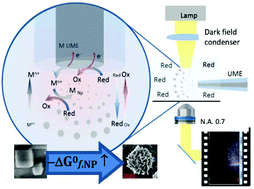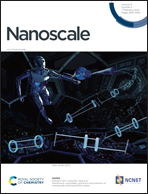Effect of the driving force on nanoparticles growth and shape: an opto-electrochemical study†
Abstract
Most protocols developed to synthesize nanoparticles (NPs) and to control their shape are inspired from nucleation and growth theories. However, to rationalize the mechanisms of the shape-selective synthesis of NPs, experimental strategies allowing to probe in situ the growth of NPs are needed. Herein, metal Au or Ag nanoparticles (NPs) are produced by reaction of a metallic ion precursor with a reversible redox reducer. The process is explored by an oxidative electrosynthesis strategy using a sacrificial Au or Ag ultramicroelectrode to both trigger the metallic ion generation and control the local concentrations of the different reactants. The effect of the driving force for the metallic ion reduction over metal NP growth dynamics is inspected in situ and in real time at the single NP level by high-resolution optical microscopy from the tracking of the Brownian trajectories of the growing NPs in solution. The NP reductive growth/oxidative etching thermodynamics, and consequently the NP shape, are shown to be controlled electrochemically by the reversible redox couple, while the intervention of an Au(I) intermediate ion is suggested to account for the formation of gold nanocubes.



 Please wait while we load your content...
Please wait while we load your content...